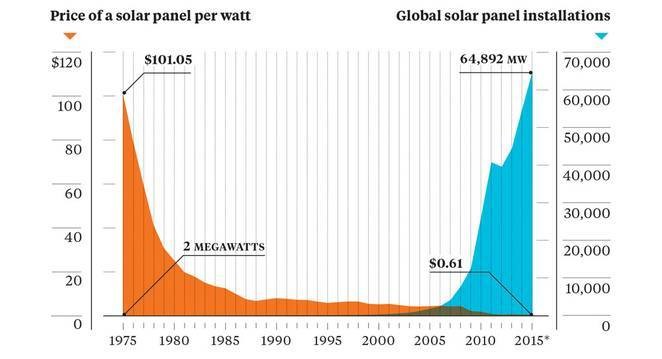Dubai is building the world’s biggest solar power plant

The emirate is hoping to generate 7% of its total power from clean energy by 2020 Image: REUTERS/Stringer
Dubai has announced plans to build the world’s largest concentrated solar power (CSP) facility by 2030 as part of a wider push towards renewable energy.
The plant, located within the Mohammed bin Rashid Al Maktoum Solar Park, is set to generate 1,000 megawatts of power by 2020, and up to five times that amount by 2030.
The announcement comes after Morocco just switched on the $765 million Noor-Ouarzazate complex, which is projected to generate about 580 megawatts of power by 2020, enough to meet the needs of more than 1 million people.
Currently, the world’s largest solar plant, the Ivanpah CSP in California, generates about 392 megawatts.
Why the switch to solar?
While demand for power has been rising in the Middle East, the costs of producing electricity from solar and other renewables are falling.

Concerns about low oil prices and the impact of climate change have laid bare the consequences of relying on fossil fuels. And unlike its oil-rich neighbours, Dubai has diminishing reserves of crude and has made efforts to diversify its economy over the past few decades.
The new CSP plant is part of the emirate’s plan to shift to renewables – Dubai is hoping to generate 7% of its total power from clean energy by 2020, followed by 25% in 2030, and 75% by 2050.
At the Middle East and North Africa Renewable Energy Conference in April, the Gulf Cooperation Council (GCC) states – Bahrain, Kuwait, Oman, Qatar, Saudi Arabia and the UAE – pledged to free up $100 billion for renewable energy projects over the next 20 years.
Countries with the most solar capacity
Based on 2014 figures from the International Energy Agency's Trends in Photovoltaic Applications report, Tech Insider has compiled a list of the top 10 countries with the most solar power capacity.
The ranking shows which countries are generating the most raw power from solar, not who is providing the greatest percentage of their nation's energy with it. Leading the way are Germany, China and Japan.
Don't miss any update on this topic
Create a free account and access your personalized content collection with our latest publications and analyses.
License and Republishing
World Economic Forum articles may be republished in accordance with the Creative Commons Attribution-NonCommercial-NoDerivatives 4.0 International Public License, and in accordance with our Terms of Use.
The views expressed in this article are those of the author alone and not the World Economic Forum.
Stay up to date:
United Arab Emirates
Forum Stories newsletter
Bringing you weekly curated insights and analysis on the global issues that matter.
More on Energy TransitionSee all
Roberto Bocca
November 17, 2025






